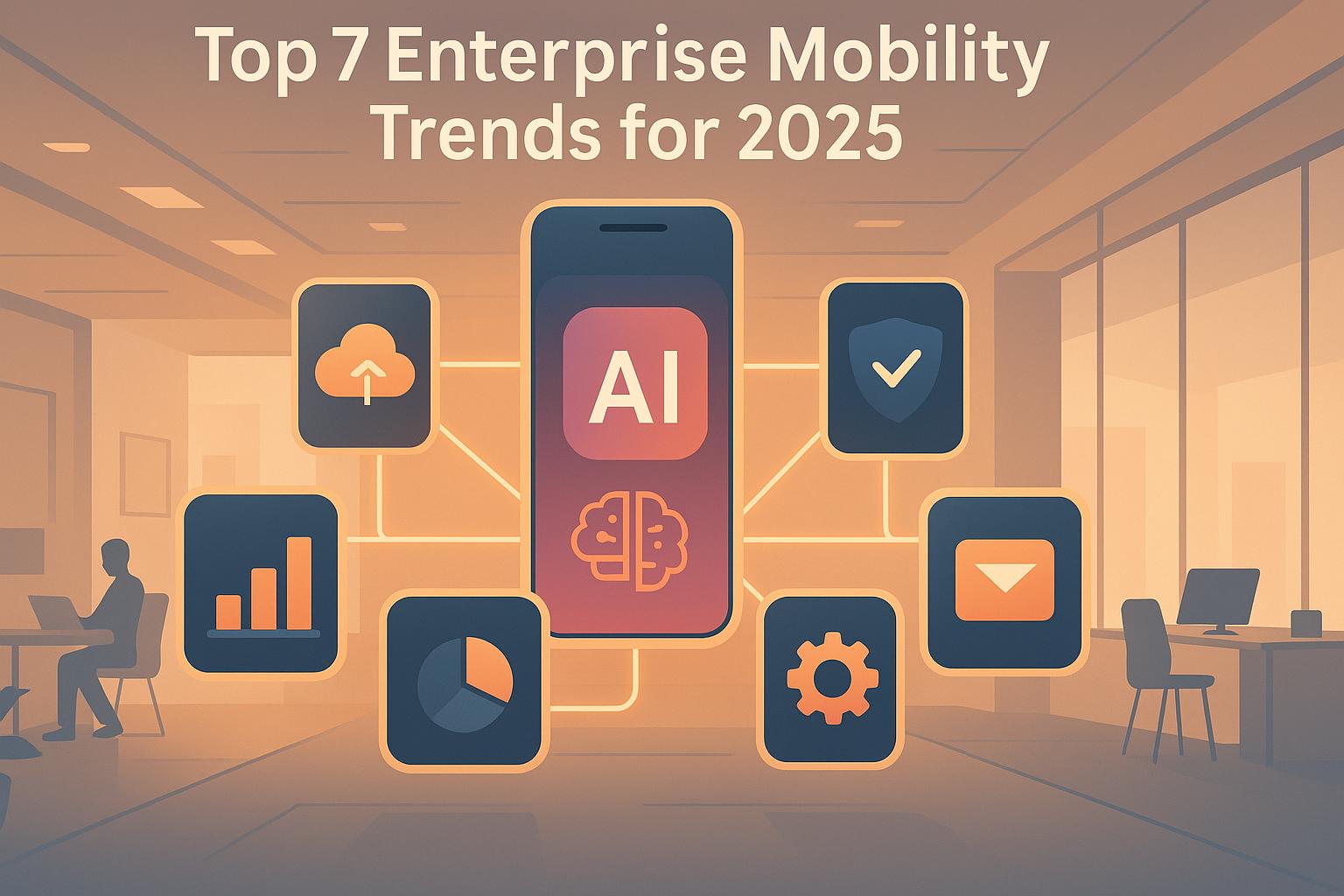Continuous compliance monitoring tools automate staying compliant with regulations like SOC 2, ISO 27001, HIPAA, GDPR, and PCI DSS. Instead of relying on manual audits, these tools provide real-time alerts, automated evidence collection, and integration with cloud platforms like AWS, Azure, and Google Cloud. Here's a quick look at the top tools:
- Drata: Automates evidence collection and supports multiple frameworks with native integrations.
- Secureframe: Offers risk-based monitoring and extensive integrations for startups and mid-sized companies.
- Sprinto: Focuses on continuous monitoring and simplifies audits for tech companies.
- MetricStream ConnectedGRC: Ideal for large enterprises, combining compliance, risk, and policy management.
- Netwrix: Specializes in data security compliance with user behavior analytics.
- Thoropass: Great for smaller businesses, pairing automation with expert guidance.
- Scrut: Provides an intuitive dashboard and supports over 50 frameworks.
These tools help reduce manual work, streamline audits, and maintain compliance across complex environments.
5 Best Compliance Management Software Tools (2024)
How to Choose the Right Tool
When it comes to leveraging continuous monitoring, selecting the right tool is a game-changer for maintaining compliance. To make the best choice, focus on the following key features:
Automated Evidence Collection is non-negotiable. The tool should automatically gather evidence - like screenshots, log files, and system change records - across your entire tech environment. This includes everything from cloud services to on-premises systems, ensuring no gaps in coverage.
Native Integrations are essential for seamless workflows. The tool should integrate effortlessly with your existing systems, such as cloud providers, identity management platforms, HR software, and security tools. This reduces the need for manual setup and keeps operations smooth.
Real-Time Alerts and Notifications are crucial for spotting compliance issues before they escalate. Look for tools that continuously monitor your systems and flag configuration changes instantly. Customizable alert levels can help you prioritize responses.
Framework Mapping and Coverage is especially important for businesses in the US. Make sure the tool supports all relevant frameworks for your industry, such as PCI DSS for payment processing, HIPAA for healthcare, SOC 2 Type II for enterprise contracts, GDPR for handling EU data, and ISO 27001 or NIST for highly regulated industries. This ensures you're prepared for audits and can manage risks effectively.
Audit Workflow Management simplifies the often cumbersome audit process. A good tool should provide features like audit trails, evidence versioning, and auto-generated compliance reports. Some even offer dedicated auditor portals to streamline collaboration.
Scalability and Performance are critical as your organization grows. The tool should be able to handle an increasing number of systems, users, and compliance frameworks without sacrificing performance.
Pricing Transparency is a must for planning your compliance budget. Opt for tools with clear pricing in USD, including details about costs for additional users, integrations, or frameworks. Don't forget to factor in expenses for implementation, training, and ongoing support.
User Experience and Training Requirements play a big role in adoption. Choose a tool with an intuitive interface and comprehensive training resources to help teams get up to speed quickly.
Reporting and Dashboard Capabilities are vital for keeping leadership and stakeholders informed. Look for tools that can generate both high-level executive summaries and in-depth technical reports, tailored to different audiences.
For additional support, check out the Top Consulting Firms Directory to connect with compliance experts who can guide you through the process.
1. Drata
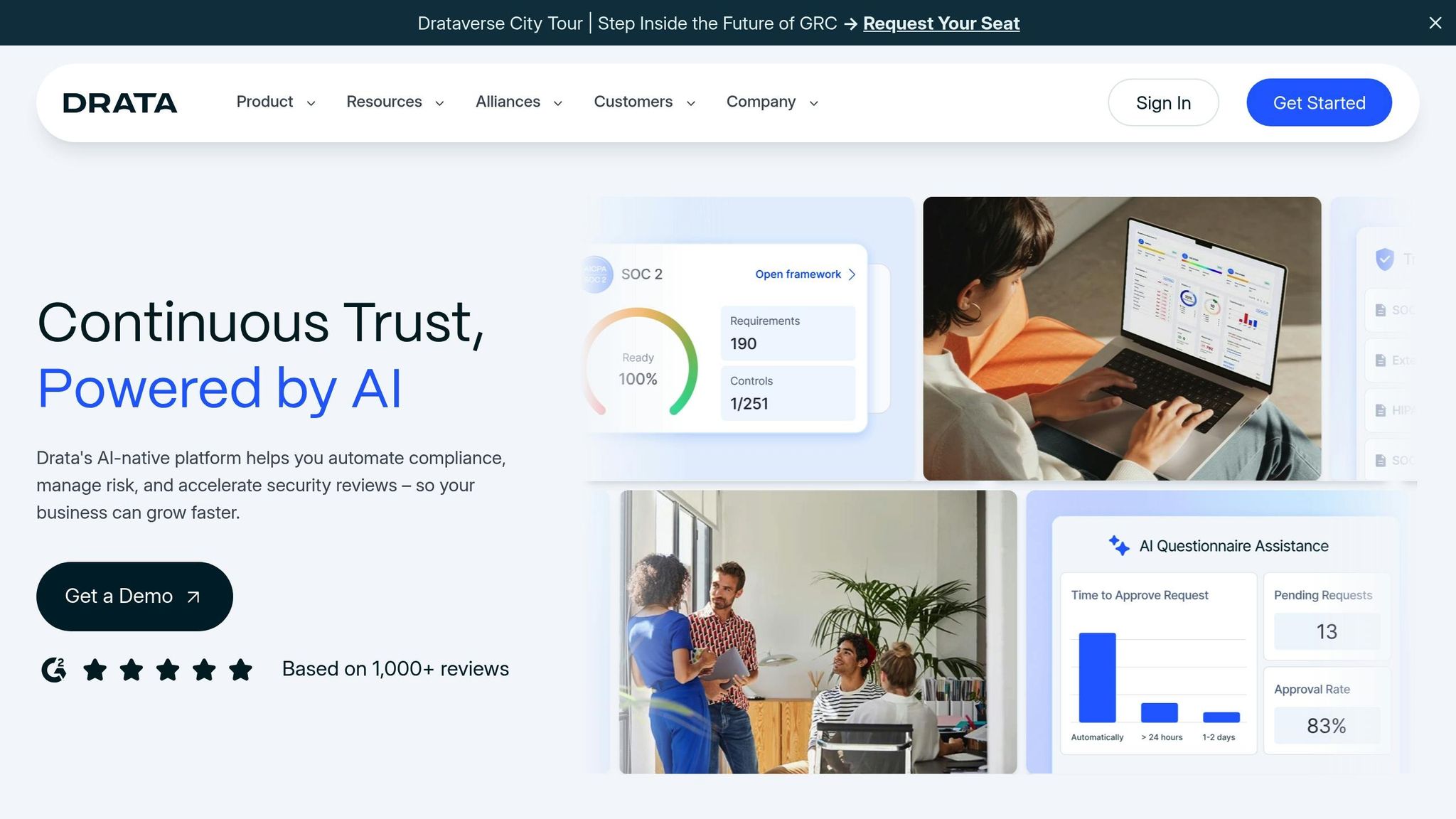
Drata is a compliance automation platform crafted for tech companies navigating multiple compliance frameworks. It's especially popular among startups and mid-sized businesses that want to simplify their compliance processes without committing large teams to manual tasks. Let’s dive into how Drata makes compliance monitoring more efficient.
Automated Evidence Collection
One of Drata’s standout features is its automated evidence collection system, which works continuously across your tech stack. The platform uses lightweight agents to scan your infrastructure, capturing data like security configurations, system logs, access reviews, and policy acknowledgments whenever changes occur.
What sets it apart is its intelligent evidence mapping. This feature organizes and links collected data directly to specific compliance requirements. For instance, when managing SOC 2 Type II controls, Drata can automatically connect cloud service logs to access control standards, cutting down on tedious manual documentation.
Native Integrations and Framework Mapping
Drata integrates seamlessly with major tools and platforms, including cloud providers like AWS, Google Cloud Platform, and Microsoft Azure; identity providers such as Okta and Azure Active Directory; HR systems like BambooHR and Workday; and security tools including Crowdstrike and Qualys.
The platform supports a wide array of compliance frameworks, such as SOC 2, ISO 27001, PCI DSS, HIPAA, and GDPR. Its framework mapping feature is a game-changer - it cross-references controls across multiple standards, allowing evidence collected for one framework to often satisfy requirements for others. This reduces the overall workload for compliance teams.
For U.S.-based companies, Drata offers tailored templates and control sets that align with American regulations and business norms. These include pre-configured policies designed to meet U.S. employment laws, data protection rules, and industry-specific regulations, making it easier for businesses to navigate the complex regulatory environment.
Real-Time Alerts and Streamlined Audits
Drata keeps you informed with real-time alerts delivered via Slack, email, or in-platform notifications whenever configuration changes occur. When it comes to audits, the platform simplifies the process with dedicated auditor portals and auto-generated compliance reports.
Its audit workflow tools are designed for efficiency. External auditors can access necessary evidence through secure portals without needing full system access. Drata also maintains detailed audit trails, logging when evidence was gathered, who accessed it, and any changes over time.
During audits, the platform generates compliance reports that include executive summaries for leadership teams and detailed technical documentation for auditors. Everything is formatted to meet industry standards, ensuring the process runs smoothly.
Scalability and Transparent Pricing
Drata uses a straightforward, per-employee pricing model that scales with your company’s size and compliance needs. This pricing approach includes implementation support and training, so businesses can avoid unexpected costs.
Built to grow with your organization, Drata allows companies to start with basic SOC 2 compliance and expand to frameworks like ISO 27001 or PCI DSS as needed, without major adjustments. Its robust architecture is designed to handle increasing data and user demands, making it a fit for businesses of various sizes.
For those seeking extra guidance, the Top Consulting Firms Directory connects businesses with compliance consultants skilled in optimizing Drata setups. Up next, we’ll take a closer look at how Secureframe tackles continuous compliance monitoring.
2. Secureframe
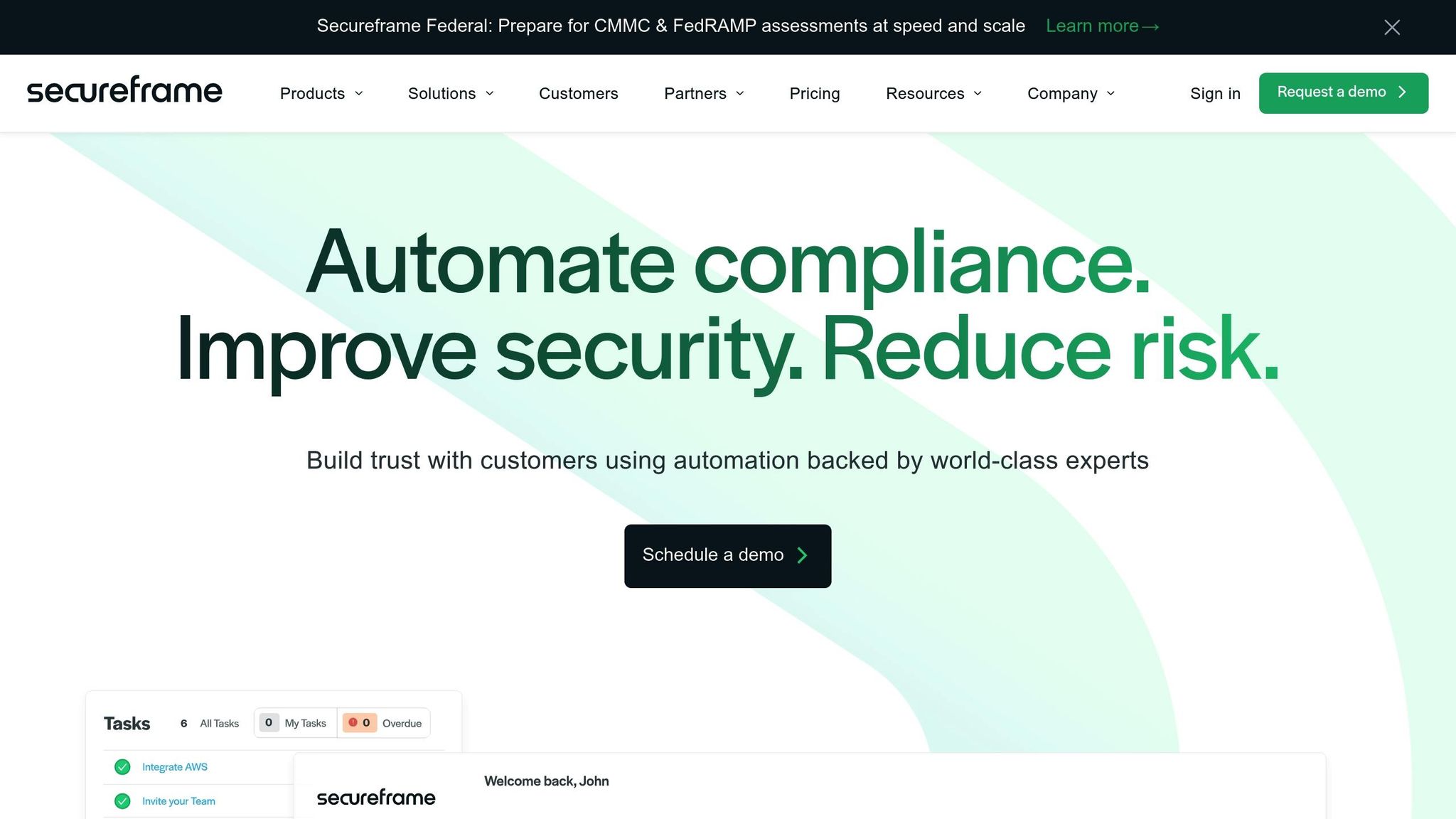
Secureframe is a compliance automation platform tailored for technology companies aiming to achieve multiple security certifications. It simplifies both the initial setup and ongoing monitoring, helping businesses avoid the need to expand internal compliance teams.
Continuous Control Monitoring and Automated Evidence Collection
Secureframe's monitoring engine continuously scans your technology infrastructure, capturing evidence in real time instead of relying on periodic checks. Lightweight agents are deployed to monitor configuration changes, user access, and security events as they happen.
The platform's automated evidence collection system organizes compliance artifacts according to the specific frameworks you're working toward. It maintains detailed timestamps and change logs, ensuring a clear audit trail for reviewers. What sets it apart is its risk-based monitoring approach. Instead of treating all compliance controls equally, Secureframe focuses more frequent monitoring on high-risk areas while applying standard checks to less critical systems. This approach ensures that the most sensitive parts of your infrastructure get the attention they need.
Native Integrations and Framework Mapping
Secureframe seamlessly integrates with leading cloud providers, identity management systems, and development tools, creating a unified compliance ecosystem.
The platform supports major compliance frameworks like SOC 2 Type I and II, ISO 27001, PCI DSS Level 1, HIPAA, and GDPR. For businesses pursuing multiple certifications, Secureframe leverages cross-framework intelligence, allowing evidence collected for one framework to meet similar requirements in others. Additionally, U.S.-based companies can benefit from pre-built templates designed to align with regulatory requirements.
Real-Time Alerts and Audit Workflows
Secureframe's alert system ensures you're always in the loop, delivering notifications through email, Slack, Microsoft Teams, and mobile push notifications. Alerts are prioritized based on risk, so you can focus on what matters most.
To ease the administrative workload, Secureframe offers tools that streamline audit workflows. External auditors gain access to a dedicated portal where they can review evidence, request additional documents, and communicate directly with your team. The platform also generates audit-ready reports, complete with executive summaries, detailed control testing results, and remediation timelines. During the audit process, Secureframe provides a collaborative workspace where internal teams can track auditor requests, upload supplementary evidence, and monitor progress. Its timeline feature ensures teams stay on track by offering clear milestones and deadline reminders.
Scalability and Pricing Transparency
Secureframe operates on a per-employee pricing model, adjusting costs based on your company's size and the number of compliance frameworks you're working toward. This pricing includes implementation support, ongoing customer success services, and access to compliance experts who guide you through the certification process. As your business grows, the platform adapts its monitoring scope and compliance requirements accordingly.
For organizations seeking additional support, the Top Consulting Firms Directory connects you with specialized consultants who can help you maximize Secureframe's capabilities and navigate industry-specific regulations.
Next, we’ll take a closer look at Sprinto and its unique approach to continuous compliance monitoring.
3. Sprinto
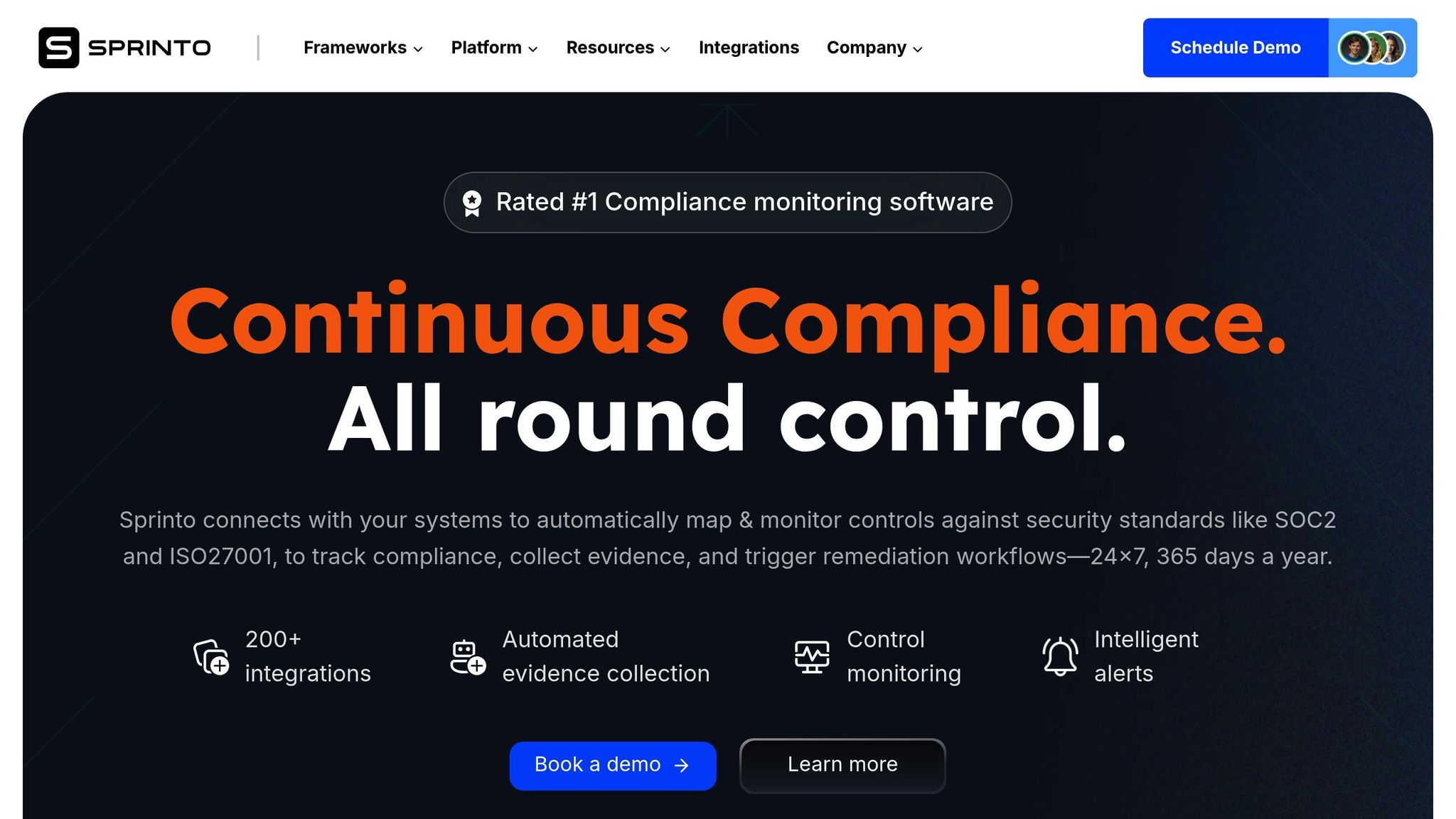
Sprinto is a compliance automation platform tailored for growing tech companies aiming to achieve multiple certifications. It combines automated tools with expert guidance to simplify the compliance process, focusing on continuous monitoring and real-time documentation.
Continuous Control Monitoring and Automated Evidence Collection
Sprinto uses lightweight agents to continuously monitor the security posture of your infrastructure, spanning cloud environments, applications, and endpoints. Unlike older compliance tools that rely on periodic snapshots, Sprinto captures evidence as it happens, providing real-time insights.
Its automated evidence collection system is designed to meet the unique requirements of various compliance frameworks. When a configuration change or security event occurs, Sprinto categorizes and timestamps evidence based on specific control requirements. This automation significantly reduces the manual work usually needed for compliance documentation.
Sprinto also offers context-aware monitoring that evaluates the compliance impact of each piece of evidence. By identifying potential issues early, it allows companies to address gaps during day-to-day operations rather than scrambling during audits.
Native Integrations and Framework Mapping
Sprinto integrates seamlessly with a wide range of business tools, including major cloud providers like AWS, Google Cloud Platform, and Microsoft Azure. It also connects with identity management systems, development platforms, and security tools, creating a centralized compliance ecosystem that automatically pulls data from your tech stack.
The platform supports key compliance frameworks such as SOC 2 Type I and II, ISO 27001, GDPR, HIPAA, and PCI DSS. By identifying overlapping requirements across these standards, Sprinto enables organizations to reuse evidence collected for one certification to meet others, cutting down on administrative work for companies pursuing multiple certifications.
For U.S.-based organizations, Sprinto provides templates that address local regulatory needs and industry-specific guidelines. Its framework library is updated regularly to reflect changes in compliance standards and new regulatory requirements.
Real-Time Alerts and Audit Workflows
Sprinto prioritizes compliance alerts based on risk, sending notifications via email, Slack, Microsoft Teams, and in-platform dashboards. This ensures that critical issues are addressed promptly while lower-priority concerns are managed appropriately.
The platform also includes a dedicated auditor portal, giving external reviewers organized access to compliance evidence, supporting documents, and communication tools. This reduces the back-and-forth typically associated with audits, allowing auditors to track progress, request additional information, and provide feedback directly within the platform.
For internal teams, Sprinto offers a collaborative workspace to manage audit tasks. With features like automated reminders and deadline tracking, teams can stay on top of assignments and maintain order during the audit process.
Scalability and Pricing Transparency
Sprinto operates on a subscription-based pricing model that adjusts based on company size and the number of frameworks being pursued. The platform offers implementation support, ongoing customer success services, and access to compliance experts to guide organizations through the certification process.
Built to handle enterprise-scale deployments, Sprinto can seamlessly support complex and distributed technology infrastructures. Its reporting tools allow companies to generate compliance dashboards and audit reports for multiple business units or subsidiaries, all from a single platform.
For more insights on implementing Sprinto effectively, check out the Top Consulting Firms Directory. Up next, we’ll explore MetricStream ConnectedGRC and its approach to enterprise compliance.
4. MetricStream ConnectedGRC
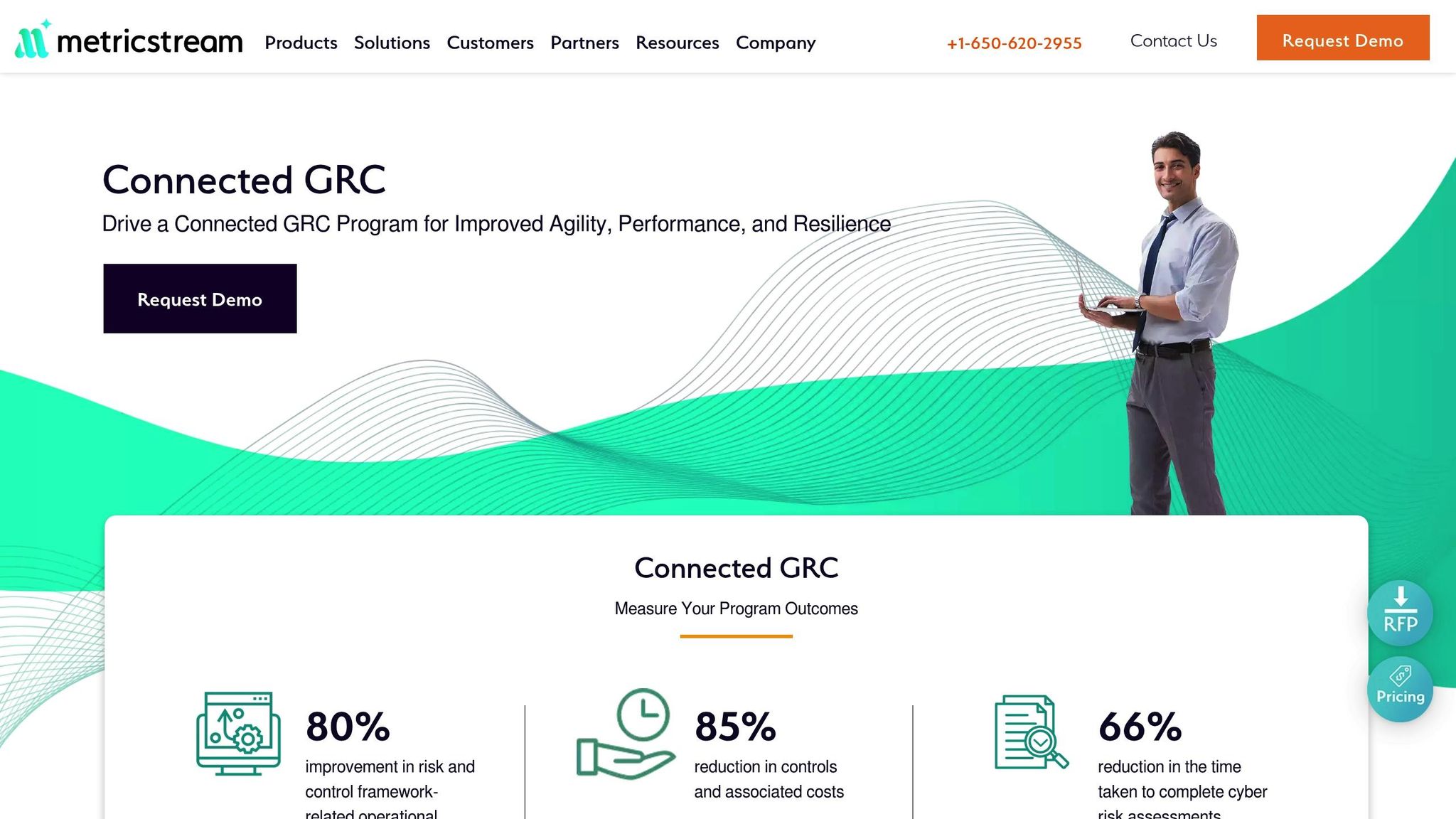
MetricStream ConnectedGRC is a governance, risk, and compliance (GRC) platform built to meet the needs of large organizations. It combines risk assessment, policy management, and continuous monitoring into a unified system that can scale across multiple business units and regions.
Continuous Control Monitoring and Automated Evidence Collection
MetricStream's ConnectedRisk engine keeps a close watch on control performance across the organization. Using risk-based sampling, it focuses on high-risk areas while maintaining baseline checks on all controls. This ensures that critical risks receive priority attention over routine controls.
When controls fail, the platform automatically escalates issues based on pre-set risk thresholds and business impact assessments. MetricStream goes beyond basic data collection with its intelligent correlation capabilities, linking related compliance events across various business processes. For instance, if a security incident occurs in IT, the system flags related controls in areas like data privacy, operational risk, and vendor management that could be affected.
Native Integrations and Framework Mapping
MetricStream integrates seamlessly with more than 200 enterprise applications and supports over 500 regulatory frameworks, such as SOX, COSO, ISO 27001, NIST, GDPR, and sector-specific regulations like Basel III for banking and NERC CIP for utilities. Its Universal Data Connector enables organizations to pull compliance data from almost any system that supports APIs or file-based data exchange.
The platform’s Framework Harmonization feature identifies overlapping requirements across different standards, helping organizations simplify their compliance processes. With localized templates and workflows tailored to specific jurisdictions, MetricStream also consolidates reporting at the corporate level. This is especially useful for U.S. companies with operations in Europe, where GDPR compliance must align with domestic regulations. These integrations and harmonization tools facilitate proactive alerts and make audits more efficient.
Real-Time Alerts and Audit Workflows
MetricStream uses predictive analytics to deliver real-time alerts, identifying potential issues before they escalate. By analyzing historical trends and current risk indicators, the platform provides early warnings, giving compliance teams time to act.
The audit management module is designed for seamless collaboration with external auditors. Through AuditBridge, secure workspaces allow external auditors to access necessary documentation, submit requests, and monitor audit progress without compromising sensitive data. Detailed audit trails ensure transparency, showing exactly what was accessed and when.
Internally, MetricStream supports both risk-based and cyclical audit approaches. It automatically creates audit plans based on risk assessments and regulatory requirements, then tracks progress against deadlines. Features like smart scheduling help audit teams manage their workload more effectively by combining related audits and avoiding resource conflicts.
Scalability and Pricing Transparency
MetricStream uses an enterprise licensing model, with pricing determined by the number of users, business units, and regulatory frameworks managed. It is built to accommodate large-scale organizations with thousands of users across multiple locations. Deployment options include on-premises, cloud, and hybrid configurations, with support for multi-tenant setups and Compliance-as-a-Service offerings.
The platform also provides dedicated customer success support, including implementation assistance, training, and ongoing reviews for optimization. This enterprise-focused approach ensures that organizations can achieve comprehensive compliance across complex operational landscapes.
For those considering a GRC platform like MetricStream, consulting with specialists through the Top Consulting Firms Directory can help ensure smooth deployment and integration. Up next, we'll dive into Netwrix and its expertise in data security compliance monitoring.
sbb-itb-97f6a47
5. Netwrix
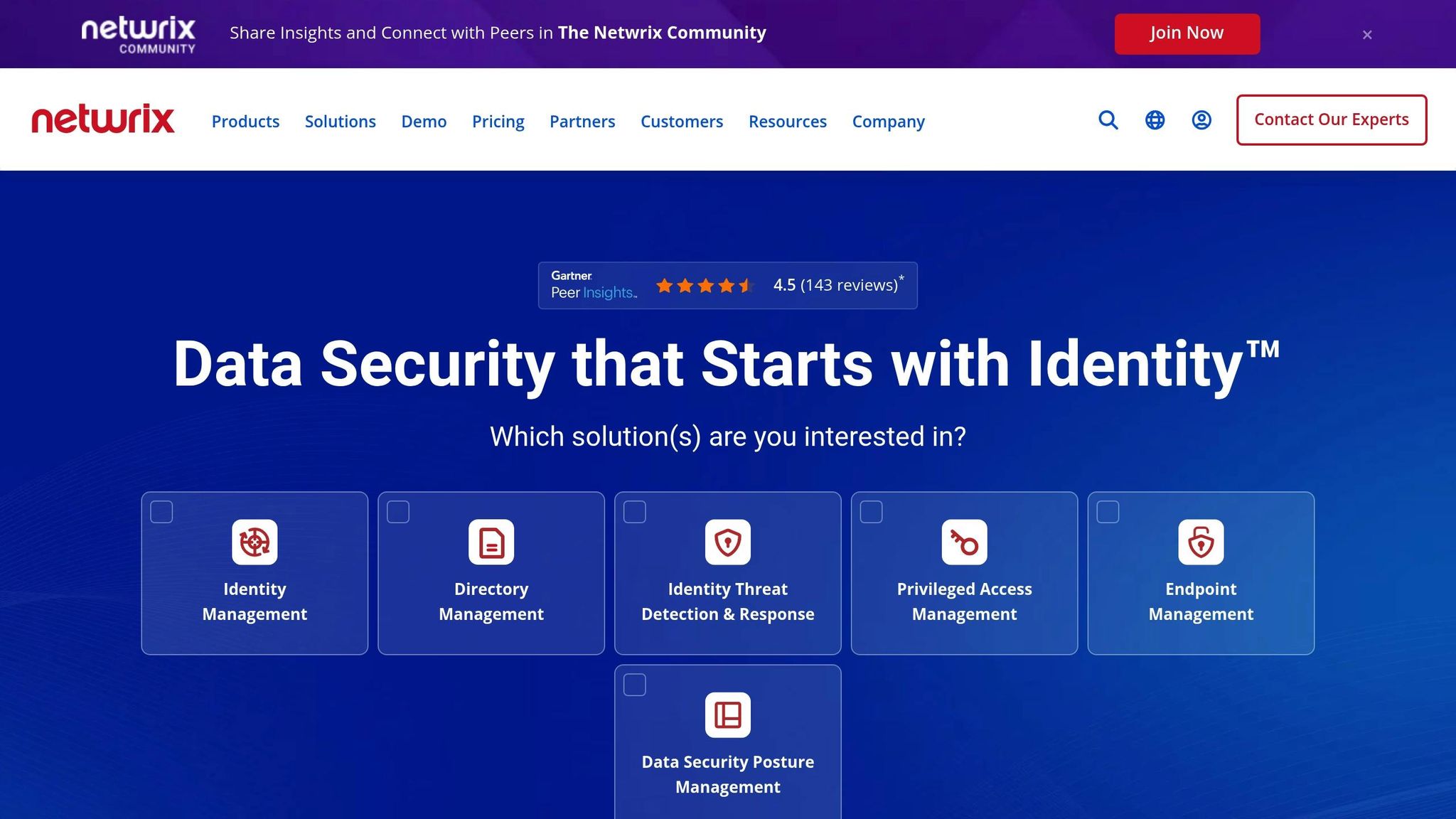
Netwrix focuses on data security compliance monitoring, placing a strong emphasis on safeguarding sensitive information in hybrid IT environments. Its key strengths lie in data classification and user activity monitoring, which align with broader continuous compliance strategies. Unlike general GRC platforms, Netwrix hones in on data governance, user behavior analytics, and privileged access management to help organizations meet data protection regulations.
Continuous Monitoring and Automated Evidence Collection
Netwrix's Data Classification Engine is designed to automatically discover and tag sensitive data across file systems, databases, and cloud storage. It keeps a constant watch on data access, logging details like timestamps, user identities, and access locations.
The platform uses behavior analytics to create baseline profiles for individual users, flagging anomalies like unexpected file access or bulk downloads. Meanwhile, privileged account actions are tracked across systems to build detailed audit trails, ensuring a clear record of activity.
Seamless Integrations and Compliance Framework Mapping
Netwrix integrates natively with platforms like Microsoft Active Directory, Azure AD, AWS, and Google Cloud Platform, pulling user and permission data without requiring additional agents. These integrations are mapped to compliance frameworks such as:
- SOX Section 404: Financial controls
- HIPAA: Healthcare data protection
- PCI DSS: Payment card security
For GDPR compliance, Netwrix supports organizations in managing data subject requests, such as access, deletion, and portability inquiries. It also maintains detailed records of data processing activities. Additionally, its monitoring capabilities for platforms like SharePoint and Exchange ensure secure handling of sensitive communications.
Real-Time Alerts and Streamlined Audit Workflows
Netwrix provides risk-scored alerts for unusual activity involving sensitive data. High-risk events - such as bulk file downloads or after-hours data queries - immediately notify security and compliance teams. The platform’s audit workflow system simplifies compliance reporting by logging key details like access permissions, changes, timestamps, approvals, and justifications required for external audits.
For deeper investigations, the investigation workbench allows compliance teams to analyze incidents by correlating user activities across systems, creating a clear timeline for potential breaches.
Flexible Deployment and Transparent Pricing
Netwrix operates on a per-user licensing model with volume discounts, offering deployment options both on-premises and in the cloud. Typical deployments are completed within weeks and include data discovery, baseline setup, and custom alert configuration.
The platform also features compliance dashboards, providing insights into metrics like detection times, classification accuracy, and overall compliance trends.
This focus on data-driven compliance monitoring makes Netwrix a standout option. As we explore other tools, we’ll see how alternative approaches to continuous compliance management compare.
6. Thoropass
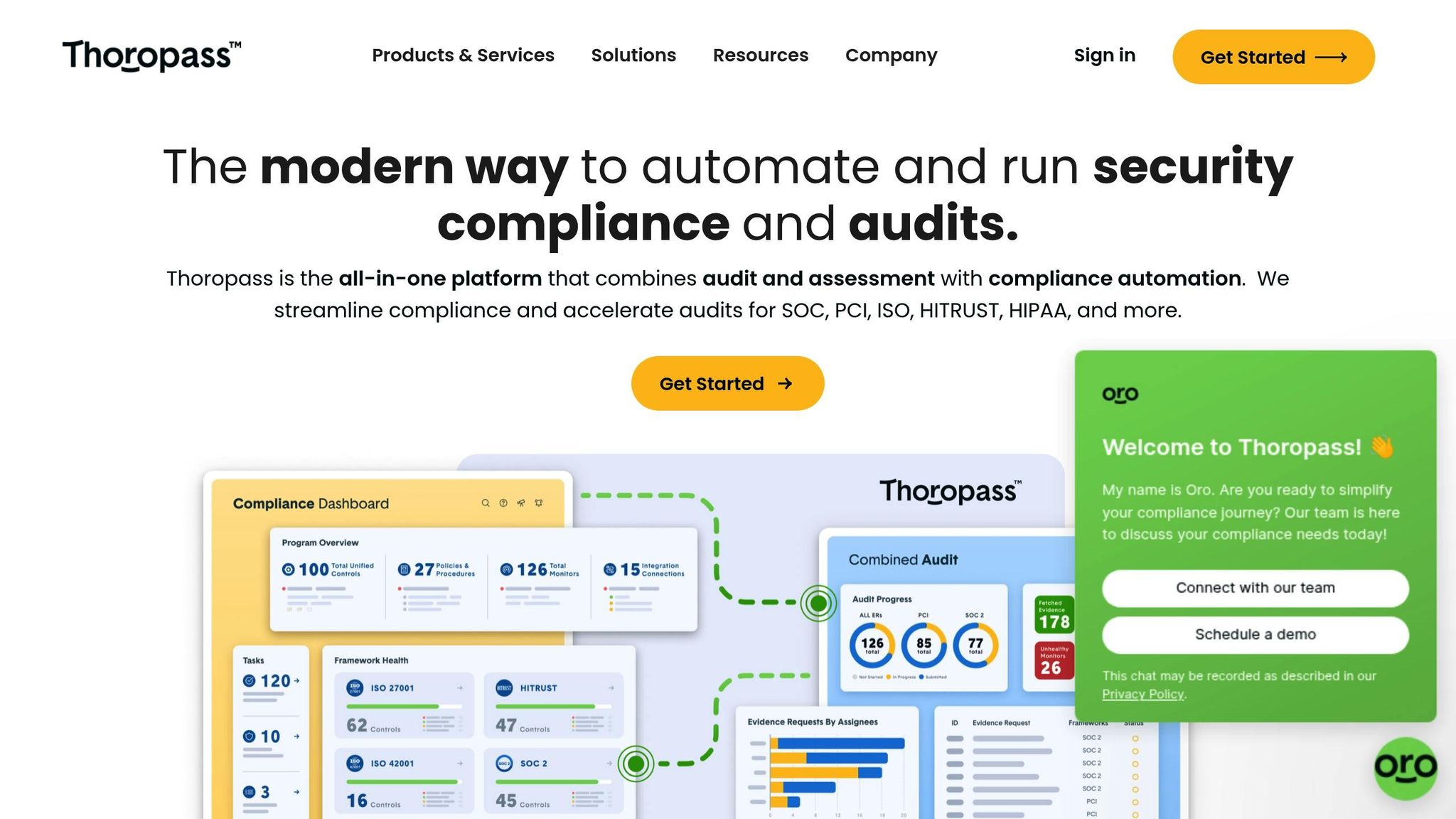
Thoropass is a compliance automation platform designed to simplify the certification process for businesses, especially startups and scale-ups. By pairing automated monitoring with expert guidance through its white-glove service model, Thoropass assigns compliance specialists to work closely with clients throughout their certification journey. This hands-on support is especially useful for smaller organizations without dedicated compliance teams.
What sets Thoropass apart is its ability to address a common challenge: navigating the complexities of certifications like SOC 2 Type II or ISO 27001 without in-house expertise.
Continuous Control Monitoring and Automated Evidence Collection
At the heart of Thoropass is its Control Monitoring Engine, which automates evidence collection across critical control areas. The platform monitors security configurations, access controls, and operational processes. It tracks key areas such as multi-factor authentication, password policies, and access review cycles, while also integrating with security scanning tools to document patch management and vulnerability remediation timelines.
Thoropass also automates onboarding and offboarding evidence collection. For vulnerability management, this eliminates the need for manual tracking, a step that can be particularly time-consuming for companies just starting their compliance journey.
Native Integrations and Framework Mapping
Thoropass integrates seamlessly with widely used business tools like Okta, Google Workspace, AWS, GitHub, and Slack. These integrations enable real-time data collection to confirm that security controls are functioning as intended.
The platform maps this collected evidence to specific frameworks, including SOC 2 Type II trust service criteria and the 114 controls outlined in ISO 27001. It also supports HIPAA and PCI DSS frameworks, though its primary focus is on helping technology companies achieve foundational security certifications.
Real-Time Alerts and Audit Workflows
Thoropass provides real-time alerts for critical control failures, notifying both the client and their assigned compliance expert. Its pre-audit assessments review collected evidence to identify potential gaps before an audit begins.
When preparing for audits, the platform's audit workflow system organizes evidence by control area, streamlining the review process for external auditors. It tracks auditor requests, manages evidence submissions, and maintains a detailed timeline of all audit-related activities. This proactive system helps companies avoid delays and costly audit findings.
Scalability and Pricing Transparency
Thoropass operates on a subscription-based pricing model that includes both software and expert services. Pricing typically ranges from $2,000 to $8,000 per month, depending on company size and certification needs. Most initial engagements span 6 to 12 months.
The platform is designed to grow with its clients, adjusting its monitoring scope as new systems and processes are introduced. However, it’s best suited for companies with fewer than 500 employees. Larger enterprises with more complex compliance needs may require a different solution.
7. Scrut
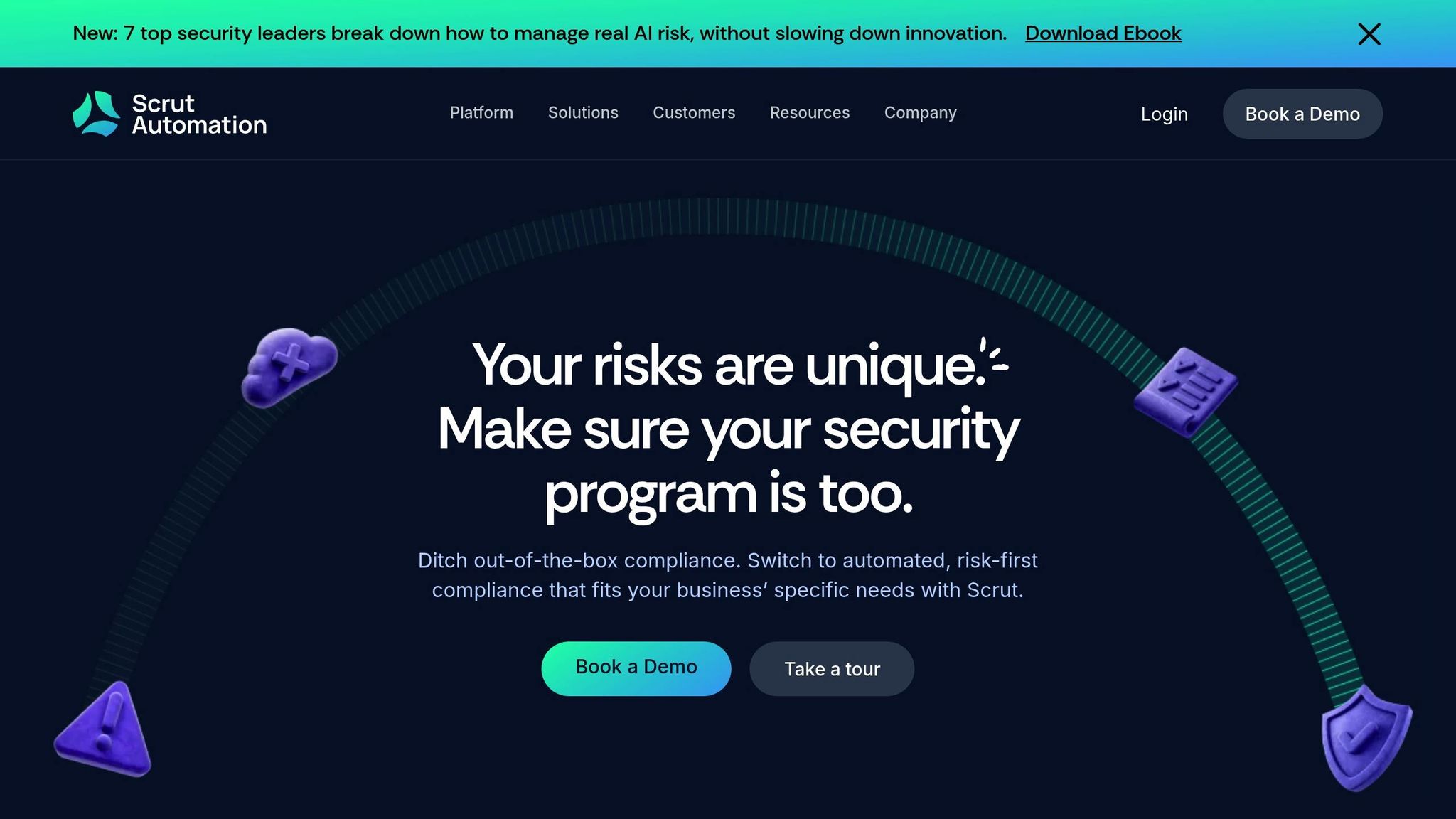
Scrut is a compliance automation platform designed to simplify continuous compliance monitoring for mid-market tech companies. With its intuitive dashboard, it helps businesses manage multiple compliance frameworks more efficiently.
Continuous Monitoring and Automated Evidence Collection
Scrut employs lightweight agents and API connections to keep a constant eye on critical security controls. It also automates the collection of evidence needed for compliance requirements, saving time and reducing manual effort. The platform streamlines policy lifecycle tracking and works with vulnerability scanning tools to monitor remediation efforts while documenting the resolution process.
Seamless Integrations and Framework Alignment
Scrut integrates seamlessly with tools like Microsoft 365, Salesforce, Jira, ServiceNow, Azure, and Google Cloud Platform. It maps collected evidence to widely-used compliance frameworks such as SOC 2, ISO 27001, GDPR, HIPAA, and PCI DSS. This makes the evidence collection process straightforward. For added flexibility, organizations can customize their compliance programs to meet specific industry needs or internal security standards.
Smart Alerts and Audit Support
Scrut’s alert system helps prioritize risks by flagging critical control failures, ensuring teams focus on what matters most. Its audit preparation tools allow businesses to create tailored evidence packages and provide secure access for auditors. A continuous gap analysis feature compares the organization’s current compliance status against framework requirements, helping address potential issues before formal audits. These features make Scrut a strong option for businesses seeking proactive compliance management.
Flexible Plans and Scalable Features
Scrut offers tiered subscription plans to cater to organizations of different sizes and needs. From basic monitoring to advanced features like workflow automation, custom reporting, and dedicated support, businesses can scale their use of Scrut as they grow. Its modular design allows companies to start small and add features like risk assessment, vendor management, or incident response as needed. Implementation timelines depend on system complexity, with dedicated specialists available to assist with deployment and user onboarding.
Tool Comparison Chart
This chart provides a quick side-by-side comparison of compliance monitoring tools, summarizing their key features to help you make an informed choice.
| Tool | Supported Frameworks | Integration Breadth | Best Fit Organization Size | Key Differentiators | G2 Rating |
|---|---|---|---|---|---|
| Drata | SOC 2, ISO 27001, HIPAA, GDPR, PCI DSS, CCPA, ISO 27701, Microsoft SSPA, NIST CSF, NIST 800-171, NIST AI RMF, ISO 42001 | 200+ applications including AWS, Azure, and DevOps tools | Mid-market to enterprise | Adaptive Automation and deep AWS integrations | 4.9/5 |
| Secureframe | SOC 2, ISO 27001, PCI DSS, CCPA, GDPR, HIPAA | 300+ integrations with cloud and business applications | Startups to mid-market | Extensive integration ecosystem and user-friendly interface | 4.2/5 |
| Sprinto | 20+ frameworks including SOC 2, ISO 27001, HIPAA, GDPR, PCI DSS | 200+ business system integrations | Mid-market tech companies | Strong automation focus with continuous monitoring | 4.8/5 |
| MetricStream ConnectedGRC | Risk Management, Compliance, Policy, Audit, IT & Cybersecurity, ESG (GRI, SASB, TCFD) | Cross-departmental synchronization with flexible assessment modules | Large enterprises | Comprehensive GRC suite beyond just compliance | Not specified |
| Netwrix | HIPAA, GDPR | Data security focused integrations | Organizations with sensitive data | Specialized in unstructured and sensitive content protection | Not specified |
| Thoropass | HIPAA, SOC, PCI DSS, HITRUST, ISO 27001 | Integration setup varies by existing security tools | Healthcare and regulated industries | Industry-specific compliance expertise | Not specified |
| Scrut | 50+ frameworks including SOC 2, ISO 27001, GDPR, HIPAA, PCI DSS | Major cloud providers and enterprise tools | Mid-market tech companies | Intuitive dashboard with smart risk prioritization | 4.9/5 |
Each tool brings unique strengths to the table. For example, Scrut supports over 50 frameworks, while others like Netwrix focus on protecting sensitive data. Integration capabilities also vary, from Secureframe’s extensive 300+ connections to Drata’s specialized AWS integrations.
Here’s what users are saying:
"Drata's deep AWS integrations and Adaptive Automation elevate our compliance program to a new standard", shares Michael Kipp from ChurnZero.
Enterprise organizations often lean toward MetricStream ConnectedGRC for its governance and risk management suite, while mid-sized companies prefer tools like Drata, Sprinto, or Scrut for their balance of features and usability. Startups typically choose Secureframe for its ease of implementation and broad integration options.
High G2 ratings, like 4.9/5 for Drata and Scrut, highlight their effectiveness in streamlining compliance processes and reducing manual work.
"Scrut gives you a very organized platform to gather all your audit requirements. We were also able to integrate our internal productivity tool", says Esosa Taire, Technical Program Manager at Fintech Galaxy.
When deciding, consider your compliance goals, tech stack, and the size of your organization to find the best fit.
Conclusion
Picking the right continuous compliance monitoring tool can transform tedious manual tasks into seamless, around-the-clock processes. Tools like Drata, Secureframe, Sprinto, MetricStream ConnectedGRC, Netwrix, Thoropass, and Scrut each bring distinct strengths to tackle various compliance challenges.
The key is to choose a tool that fits your technology stack, meets your regulatory needs, and aligns with your budget. This ensures your monitoring efforts stay on track with your compliance objectives.
That said, implementing these tools can be tricky, especially with the ever-changing regulations in industries like finance, IT, healthcare, and e-commerce. This is where consulting firms come in. They offer expert guidance to refine compliance programs, conduct gap analyses, and assess program maturity - ensuring your chosen tool meets both your goals and regulatory demands.
For businesses navigating complex compliance requirements, the Top Consulting Firms Directory is a helpful resource. It connects you with experts in areas like digital transformation, cybersecurity, risk management, and regulatory compliance. These advisors focus on crafting tailored solutions instead of one-size-fits-all recommendations.
FAQs
What should businesses look for when selecting a continuous compliance monitoring tool?
When choosing a continuous compliance monitoring tool, it's important to zero in on a few key elements. Look for a tool that delivers precision, handles scaling effortlessly, and supports real-time monitoring to keep up with your compliance demands. It should also come with customization options, allowing you to tailor it to your specific regulatory needs, while covering a broad range of applicable rules and standards.
Key features to consider include policy management, risk assessment capabilities, and audit support to streamline your compliance efforts. Opt for tools that are not only dependable but also easy to use, ensuring they integrate smoothly into your current workflows without causing disruptions.
How do compliance tools work with existing cloud platforms and security systems?
Compliance tools are built to work effortlessly with major cloud platforms such as AWS, Microsoft Azure, and Google Cloud, along with existing security systems. They use APIs and pre-built integrations to allow businesses to keep a close eye on their cloud environments in real time.
These tools take care of automating compliance checks, enforcing security policies, and generating detailed reports to ensure all regulatory requirements are met. With features like policy-as-code and continuous monitoring, they help organizations stay secure while keeping up with changing compliance standards.
What are the main advantages of using automated evidence collection for compliance monitoring?
Automated evidence collection brings several important benefits to compliance monitoring. For starters, it dramatically enhances efficiency, cutting down the time spent on manual tasks - often by as much as 70-80%. This frees up teams to concentrate on more strategic and impactful initiatives instead of getting bogged down by repetitive processes.
It also boosts data accuracy by reducing the risk of human error, ensuring that compliance records are dependable and always prepared for audits. On top of that, automated systems provide real-time monitoring, which not only maintains continuous compliance but also makes audits smoother and more cost-effective for businesses.

